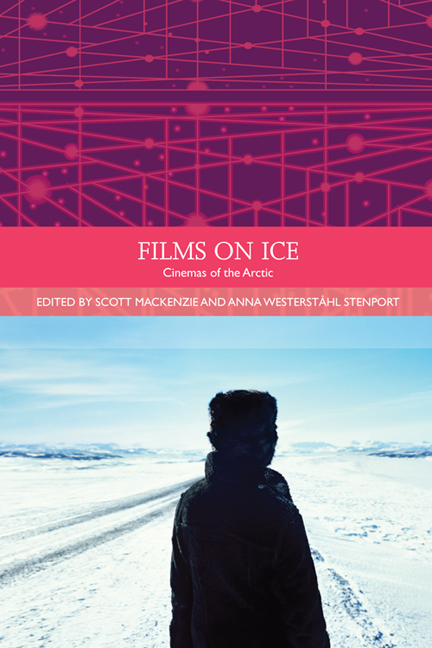Book contents
- Frontmatter
- Contents
- List of Illustrations
- Acknowledgements
- Traditions in World Cinema
- Introduction: What are Arctic Cinemas?
- PART I GLOBAL INDIGENEITY
- PART II HOLLYWOOD HEGEMONY
- PART III ETHNOGRAPHY AND THE DOCUMENTARY DILEMMA
- 14 The Creative Treatment of Alterity: Nanook as the North
- 15 From Objects to Actors: Knud Rasmussen's Ethnographic Feature Film The Wedding of Palo
- 16 Arctic Travelogues: Conquering the Soviet North
- 17 A Gentle Gaze on the Colony: Jette Bang's Documentary Filming in Greenland 1938–9
- 18 Exercise Musk-Ox: The Challenges of Filming a Military Expedition in Canada's Arctic
- 19 The Tour: A Film About Longyearbyen, Svalbard. An Interview with Eva la Cour
- PART IV MYTHS AND MODES OF EXPLORATION
- Notes on the Contributors
- Index
15 - From Objects to Actors: Knud Rasmussen's Ethnographic Feature Film The Wedding of Palo
from PART III - ETHNOGRAPHY AND THE DOCUMENTARY DILEMMA
Published online by Cambridge University Press: 05 September 2016
- Frontmatter
- Contents
- List of Illustrations
- Acknowledgements
- Traditions in World Cinema
- Introduction: What are Arctic Cinemas?
- PART I GLOBAL INDIGENEITY
- PART II HOLLYWOOD HEGEMONY
- PART III ETHNOGRAPHY AND THE DOCUMENTARY DILEMMA
- 14 The Creative Treatment of Alterity: Nanook as the North
- 15 From Objects to Actors: Knud Rasmussen's Ethnographic Feature Film The Wedding of Palo
- 16 Arctic Travelogues: Conquering the Soviet North
- 17 A Gentle Gaze on the Colony: Jette Bang's Documentary Filming in Greenland 1938–9
- 18 Exercise Musk-Ox: The Challenges of Filming a Military Expedition in Canada's Arctic
- 19 The Tour: A Film About Longyearbyen, Svalbard. An Interview with Eva la Cour
- PART IV MYTHS AND MODES OF EXPLORATION
- Notes on the Contributors
- Index
Summary
During the summer months of 1932 and 1933, the 7th Thule Expedition led an international team of researchers, under Knud Rasmussen's guidance, to Greenland's east coast. There, the team conducted cartographic work, as well as archaeological and geological investigations. In 1921, Denmark had declared the entirety of Greenland and its surrounding waters to be Danish territory, and had since that time been in open conflict with Norway. The Norwegians, independent since 1905, regarded Greenland as their historical property, and recognised only the colonies situated on the west coast as Danish territory. They were not willing to stop their long-time practice of whaling and seal-hunting in the waters off the sparsely populated east coast. Finally in 1931 and 1932, they occupied two uninhabited coastal strips north of the settlement of Scoresbysund (Ittoqqortoormiit), founded in 1924 for the purpose of marking Danish territory, and south of Ammasalik (Tasiilaq), where Gustav Holm and Vilhelm Gaarde had already encountered widespread Inuit settlements, previously unknown to the Danes, during the Umiak Expedition of 1883. When Denmark brought the case to the Permanent Court of International Justice in The Hague in the spring of 1933, Rasmussen was part of the Danish delegation. The verdict of 5 April was significantly in favour of Denmark, whose sovereignty over the entirety of Greenland had now been affirmed by the highest international legal body. Rasmussen could thus start the preparations for the second part of the 7th Thule Expedition, during which the ethnographic feature film The Wedding of Palo (Palos brudefærd, Denmark, 1934) was filmed. The expedition to the area around Ammassalik would be Rasmussen's last journey. Just before Christmas 1933, he died from pneumonia, and thus never had the chance to see the finished film, which premiered only a few months later at Palads-Teater in Copenhagen.
Contemporary recipients looked at The Wedding of Palo not only as an actual cinematic work of art, but also as a worthy monument to Rasmussen. By securing Danish polar anthropology a place at the top of this worldwide emerging discipline, Rasmussen had managed to become a major national hero during his lifetime.
- Type
- Chapter
- Information
- Films on IceCinemas of the Arctic, pp. 215 - 221Publisher: Edinburgh University PressPrint publication year: 2014

